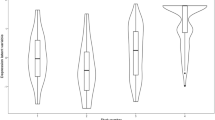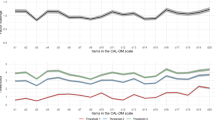Abstract.
Background:
The goal of this study was to calibrate depressive symptoms collected using different versions of the Centers for Epidemiologic Studies—Depression (CES-D) instrument in different waves of the Health and Retirement Study (HRS).
Method:
The HRS is a prospective and nationally representative cohort study. This analysis included a sample of HRS participants, adults aged 23–85 years in 1992 who had complete data on depressive symptoms at initial 2- and 4-year follow-up interviews (N = 5,734). Depressive symptoms were assessed with the CES-D. Symptom coverage and response categories varied across study wave. The first wave (1992) used a four-category response, whereas subsequent waves (1994 and 1996) used a two-category response. A structural equations model (SEM) based in Item Response Theory (IRT) was used to calibrate symptoms and generate linked depressive symptom burden scores.
Results:
Linked depressive symptom burden scores, derived from calibrated symptoms, were distributed similarly across HRS wave.
Conclusion:
Our results demonstrate the applicability of an IRT-based SEM to address a common challenge in prospective studies: changes in the content and context of symptom assessment. Future investigations may make use of our linked syndrome scores to further explore other aspects of depression from a longitudinal perspective.
Similar content being viewed by others
References
Bentler PM (1990) Comparative fit indexes in structural models. Psychol Bull 107:238–246
Bienenfeld D, Koenig HG, Larson DB, Sherrill KA (1997) Psychosocial predictors of mental health in a population of elderly women: Test of an explanatory model. Am J Geriatr Psychiatry 5:43–53
Blazer D, Burchett B, Service C, George LK (1991) The association of age and depression among the elderly: an epidemiologic exploration. J Gerontol 46:M210–215
Browne M, Cudek R (1993) Alternative ways of assessing model fit. In: Bollen K, Long J (eds) Testing structural equation models. Sage, Thousand Oaks, CA, p 136–162
Christensen H, Jorm AF, Mackinnon AJ, Korten AE, Jacomb PA, Henderson AS, Rodgers B (1999) Age differences in depression and anxiety symptoms: a structural equation modeling analysis of data from a general population sample. Psychol Med 29:325–339
Cohen J (1969) Statistical power analysis for the behavioral sciences. Academic Press, New York
Embretson SE, Reise SP (2000) Item Response Theory for psychologists. Lawrence Earlbaum Associates, Mahwah, New Jersey
Feuer M, Holland P, Green B, Bertenthal M, Hemphill F (1999) Technical aspects of links. In: Feuer M, Holland P, Green Bertenthal M, Hemphill F (eds) Uncommon measures: Equivalence and linkage among educational tests. National Academy Press, Washington, DC, p 20–47
Gallo JJ, Anthony JC, Muthén BO (1994) Age differences in the symptoms of depression: a latent trait analysis. J Gerontol 49:251–264
Gallo JJ, Cooper-Patrick L, Lesikar S (1998) Depressive symptoms of whites and African Americans aged 60 years and older. J Gerontol B Psychol Sci Soc Sci 53:277–286
Gallo JJ, Rabins PV (1999) Depression without sadness: alternative presentations of depression in late life. Am Fam Physician 60:820–826
Gallo JJ, Rabins PV, Anthony JC (1999) Sadness in older persons: 13-year follow-up of a community sample in Baltimore, Maryland. Psychol Med 29:341–350
Gallo JJ, Rabins PV, Lyketsos CG, Tien AY, Anthony JC (1997) Depression without sadness: functional outcomes of nondysphoric depression in later life. J Am Geriatr Soc 45:570–578
Gibbons RD, Clarke DC, VonAmmon CS, Davis JM (1985) Application of modern psychometric theory in psychiatric research. J Psychiatr Res 19:43–55
Goldberg D (1978) Manual of the general health questionnaire. National Educational Research Forum Publishing Company, Windsor (UK)
Hu L, Bentler P (1998) Fit indices in covariance structure analysis: Sensitivity to underparameterized model misspecifications. Psychol Methods 4:424–453
Juster F, Suzman R (1995) An overview of the Health and Retirement Study. J Human Res 30:S7-S56
Kessler RC, Andrews G, Colpe LJ, Hiripi E, Mroczek DK, Normand SLT, Walters EE, Zaslavsky AM (2002) Short screening scales to monitor population prevalences and trends in non-specific psychological distress. Psychol Med 32:959–976
Kohout FJ, Berkman LF, Evans DA, Cornoni-Huntley J (1993) Two shorter forms of the CES-D (Center for Epidemiological Studies Depression) depression symptoms index. J Aging Health 5:179–193
Kolen M, Brennan R (1995) Test Equating: Methods and Practices. Springer, New York
Lord F, Novick M (1968) Statistical theories of mental test scores. Addison-Wesley, Reading, MA
Lord FM (1953) The relation of test score to the trait underlying the test. Educ Psychol Meas 4:517–549
Macintosh R, Hashim S (2003) Variance Estimation for Converting MIMIC Model Parameters to IRT Parameters in DIF Analysis. Appl Psychol Meas 27:372–379
Murphy JM, Laird NM, Monson RR, Sobol AM, Leighton AH (2000) A 40-year perspective on the prevalence of depression: the Stirling County Study. Arch Gen Psychiatry 57:209–215
Muthén B, Lehman J (1985) Multiple group IRT modeling: Applications to item bias analysis. J Educ Stat 10:133–142
Muthén LK, Muthén BO (1998) Mplus users guide. Muthén & Muthén, Los Angeles, CA
Newmann JP (1989) Aging and depression. Psychol Aging 4:150–165
NIH Consensus Statement (1991) Diagnosis and treatment of depression in late life. In:National Institute of Mental Health, Office of Medical Applications of Research and the National Institute on Aging, Bethesda, p 27
Radloff L (1977) The CES-D Scale: A self-report depression scale for research in the general population. Appl Psychol Meas 1:385–401
Roberts RE, Kaplan GA, Shema SJ, Strawbridge WJ (1997) Does growing old increase the risk for depression? Am J Psychiatry 154:1384–1390
Rogosa D (1988) Myths about longitudinal research. In: Schaie K, Cambell R, Meredith W, Rawlings S (eds) Methodological issues in aging research. Springer Publishing Company, New York, pp 171–209
Steffick D (2000) Documentation of affective functioning measures in the Health and Retirement Study (available at http://www.umich.edu/~hrswww/docs/userg/index.html). In: Survey Research Center, University of Michigan, Ann Arbor, MI
Takane Y, De Leeuw J (1987) On the relationship between item response theory and factor analysis of discretized variables. Psychometrika 52:393–408
Teresi JA, Holmes D (2001) Some methodological guidelines for cross-cultural comparisons. J Ment Health Aging 7:13–20
Turvey CL, Wallace RB, Herzog R (1999) A revised CES-D measure of depressive symptoms and a DSM-based measure of major depressive episodes in the elderly. Int Psychogeriatr 11:139–148
US, Department of Health and Human Services (1999) Mental Health: A Report of the Surgeon General. In: US, Department of Health and Human Services,Substance Abuse and Mental Health Services Administration, Center for Mental Health Services, National Institutes of Health, National Institutes of Mental Health, Rockville, MD
Ware JE Jr, Bjorner JB, Kosinski M (2000) Practical implications of item response theory and computerized adaptive testing: a brief summary of ongoing studies of widely used headache impact scales. Med Care 38:II73–82
Ware JE, Kosinski M, Keller SD (1994) SF-36 Physical and Mental Health Summary Scales: A User’s Manual. Health Assessment Lab, Boston
Author information
Authors and Affiliations
Rights and permissions
About this article
Cite this article
Jones, R.N., Fonda, S.J. Use of an IRT-based latent variable model to link different forms of the CES-D from the Health and Retirement Study. Soc Psychiatry Psychiatr Epidemiol 39, 828–835 (2004). https://doi.org/10.1007/s00127-004-0815-8
Accepted:
Published:
Issue Date:
DOI: https://doi.org/10.1007/s00127-004-0815-8




